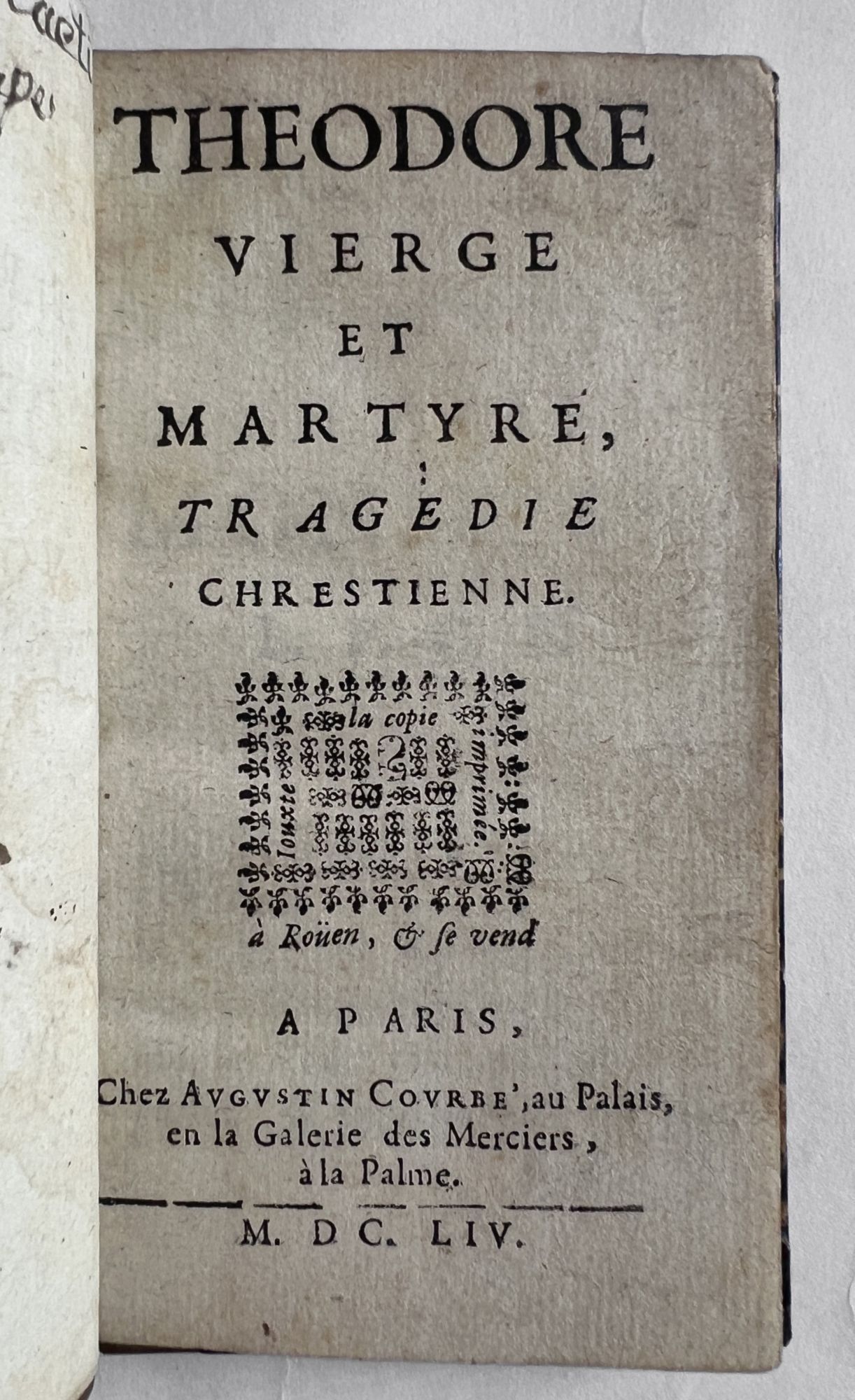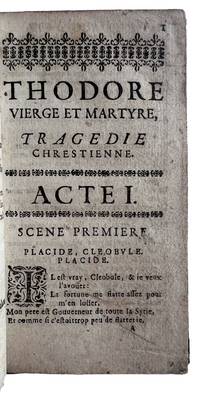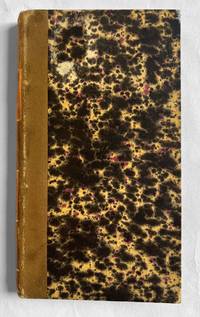Théodore Vierge et Martyre, Tragédie chrestienne
- SIGNED
- “Jouxte la copie imprimée à Rouen, et se vend à Paris: chez Augustin Courbé” [i.e., Avignon: Jean Piot], 1654
“Jouxte la copie imprimée à Rouen, et se vend à Paris: chez Augustin Courbé” [i.e., Avignon: Jean Piot], 1654. 12mo (141 x 86 mm). [10], 120 pp. Title with assemblage of printing fleurons forming a solid square incorporating the words “Jouxte la copie imprimée,” type-ornament head-pieces and initials. (Some slight discoloration.) 19th-century quarter calf; a few deckle edges. Early inscription on front flyleaf (Vraye et [?] tragebie [sic]...).***
Rare Avignon counterfeit edition of one of Corneille’s less successful tragedies. The second of his “martyr” plays, after Polyeucte, the play is based on the probably fictive 4th-century account of the martyrs Didymus and Theodora. The latter, a Christian Alexandrian noblewoman, was sent to a brothel as punishment for refusing to sacrifice to the Roman gods; she was rescued by Didymus, who disguised himself as a woman. Both died. Corneille enriched this tale with other characters, notably a second, pagan lover pining for chilly Theodora, his weak father and his domineering stepmother.
The normally crowd-pleasing combination of cross-dressing and a virgin in a brothel may have led him to expect success, but audiences spurned the play. Although praised by some contemporary critics for the originality of the plot, the clever complexity of the characters’ interactions, and “the simplicity of the style, free from pomposity or affectation” (Lancaster, p. 518), the play’s pagan characters were more interesting than its Christians, and the prostitution theme jarred with contemporary audiences’ expectations of proper tragic subjects. In his dedication to “L.P.C.B.,” Corneille indeed attributed the play’s failure to the background subject of prostitution, even though it included no brothel scenes; and he ironically praised the extreme virtue of his delicate Paris audiences.
First printed in 1646 in Rouen by Corneille’s preferred printer Laurent Maurry, for publication in Paris, Théodore enjoyed more success in print; this was the eighth edition and the second Avignon counterfeit. The kind of edition that gives provincial printing a bad name, it includes a large blooper in the drop-title opening Act 1: “THODORE, Vierge et Martyre.”
No copies in OCLC or the BnF catalogue, not in Tchémerzine. Riffaud, Répertoire du théâtre français imprimé entre 1630 et 1660, p. 248; online Riffaud: Répertoire du théâtre français imprimé 1600-1699, no. 5412, citing a copy at Rouen. Cf. H. C. Lancaster, A history of French dramatic literature in the seventeenth century (1929), pt. 2, v. 2, pp. 515-520.
Rare Avignon counterfeit edition of one of Corneille’s less successful tragedies. The second of his “martyr” plays, after Polyeucte, the play is based on the probably fictive 4th-century account of the martyrs Didymus and Theodora. The latter, a Christian Alexandrian noblewoman, was sent to a brothel as punishment for refusing to sacrifice to the Roman gods; she was rescued by Didymus, who disguised himself as a woman. Both died. Corneille enriched this tale with other characters, notably a second, pagan lover pining for chilly Theodora, his weak father and his domineering stepmother.
The normally crowd-pleasing combination of cross-dressing and a virgin in a brothel may have led him to expect success, but audiences spurned the play. Although praised by some contemporary critics for the originality of the plot, the clever complexity of the characters’ interactions, and “the simplicity of the style, free from pomposity or affectation” (Lancaster, p. 518), the play’s pagan characters were more interesting than its Christians, and the prostitution theme jarred with contemporary audiences’ expectations of proper tragic subjects. In his dedication to “L.P.C.B.,” Corneille indeed attributed the play’s failure to the background subject of prostitution, even though it included no brothel scenes; and he ironically praised the extreme virtue of his delicate Paris audiences.
First printed in 1646 in Rouen by Corneille’s preferred printer Laurent Maurry, for publication in Paris, Théodore enjoyed more success in print; this was the eighth edition and the second Avignon counterfeit. The kind of edition that gives provincial printing a bad name, it includes a large blooper in the drop-title opening Act 1: “THODORE, Vierge et Martyre.”
No copies in OCLC or the BnF catalogue, not in Tchémerzine. Riffaud, Répertoire du théâtre français imprimé entre 1630 et 1660, p. 248; online Riffaud: Répertoire du théâtre français imprimé 1600-1699, no. 5412, citing a copy at Rouen. Cf. H. C. Lancaster, A history of French dramatic literature in the seventeenth century (1929), pt. 2, v. 2, pp. 515-520.




